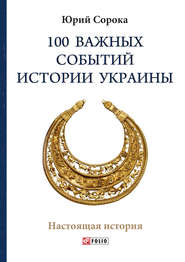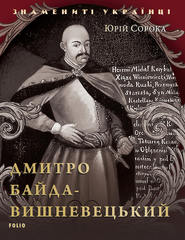По всем вопросам обращайтесь на: info@litportal.ru
(©) 2003-2025.
✖
100 Key Ukrainian Personalities
Автор
Жанр
Серия
Год написания книги
2020
Теги
Настройки чтения
Размер шрифта
Высота строк
Поля
The arrival of the fiancée of the King to France was organized pompously. Henry I set off to Reims to meet Anna. There in May 1049, at the Сathedral of Sacred Cross the coronation was held and Anna Yaroslavna became the queen of France. It is interesting that on the marriage document the daughter of Kyivan Prince wrote her name, while Henry І put a cross instead of a signature. In turn, Anna Yaroslavna surprised the king’s guard when she refused from taking the oath on the Latin Bible. She took the oath on the Gospel written in the Old Slavic language. Later that book got the name of the Reims Gospel and all the following kings of France took the oath on it, without suspecting the Kyivan origin of the book.
The years of Anna’s rule coincided with the economic and cultural booming period in France, but even in those conditions French researchers cite the lines from her letter to father, “What a Barbarian country did you send me to, father? Here houses are dull, churches are ugly and traditions are horrible…” From this letter it is possible to understand that for a well-educated Ukrainian, who had grown up in the conditions of the Slavic culture, it was hard to adapt to the conditions of the French elite of the time. However, the fact that Anna was the only woman in Europe, who corresponded with the Pope, also confirmed her high level of education.
P. Clodt. The Departure of Princess Anna Yaroslavna to France to marry King Henry I
In 1053 Anna gave birth to Philip. Over the following two years Anna also had Robert and Hugh – all legal heirs of King Henry. In addition, at that time the king and queen also had a daughter named Emma.
The marriage between Anna and Henry did not last long – the king died in 1060. According to the will, Anna Yaroslavna was appointed the regent to Philip, the heir to the throne. However, remaining the queen, she was not granted the official title of a regent: the regent could only be a man. Nevertheless, Anna, together with Philip I, signed state documents, which have been preserved up to nowadays. For instance, on the grant charter of the Soissons abbey there is her handwritten signature in Cyrillic Anna the Queen.
Jacob de Bi. Queen Anna of Kyiv, circa 1640
The final mentioning of Anna Yaroslavna was dated in documents by 1075. Her further destiny is still unclear. According to some sources, she came back to Kyiv, where she lived her later years. According to some other reports, she died in France and was buried at the church of the Villiers Abbey near the city of Etampes.
Nestor the Chronicler (? – 1013 (1014))
It happened so that little is known about the life of Nestor Chornoryasnik (Black Cassock), or the Chronicler. The man who devoted all his life to writing books and to taking down some other people’s biographies, mentioned very little about himself. However, some pieces of information about the author of imperishable The Tale of Bygone Years have reached us through the scores of centuries.
It is known that Nestor took monastic vows in 1074 or 1075. It is believed that it happened after the death of Theodosius, hegumen of the Kyiv Pechersk Monastery. In 1081, Stefan, the successor of Theodosius, gave the deacon’s rank to Nestor. In 1091, Nestor and two other monks were among the group that found the relics of St. Theodosius in the caves.
All Nestor’s later life was devoted to books. As he reminisced in his books-
“Studying books can bring a lot of use. Books punish us and teach the way to repentance, because we get wiser and more reserved after the words of the books… He who reads books communicates with God or saint men”.
V. Vasnetsov. Nestor the Chronicler. Kyiv Volodymyr Cathedral
The most prominent among Nestor the Chronicler’s books is famous The Tale of Bygone Years. We should note that the author compiled the book based on the events of the time as well as earlier chronicles, tales and folklore. It is known that wanting to write about the events in the most credible way, in 1077 Nestor went to Volyn. There, he looked for the original sources in Zymnensk and Sviatohirsk monasteries. As a result, Volyn Chronicle was nearly totally included into The Tale of Bygone Years. The Lives of Borys and Hlib is considered the first work of Nestor Chornoryasnyk. The book was released, most probably, in 1072, before Nestor himself took monastic vows and short time after the first saints of Rus’ were canonized. The second book, as Nestor recollected, was The Life of Theodosius. It is interesting to know that till nowadays some scholars have some doubts as to Nestor’s authorship. The argument of the version is that Nestor’s name is absent in all copies of The Tale but in the well-known Khlebnikovsky Copy. However, still in the XIII century chroniclers unanimously agreed that the author of The Tale was Nestor. A prominent work in the Ukrainian book making, Kyiv-Pechersk Lives of the Fathers, hints at that. On its pages, there is some information that Nestor was a great authority at the monastery and among the scholars and clergy of Kyiv.
The Tale of Bygone Years in the Radziwiłł Chronicle
It should be added that Nestor completed The Tale of Bygone Years around 1113 so its writing took him about 20 years. Thanks to the great work of the ascetic, the descendants can see glorious pages of the past, while historians now have an invaluable source of information.
The Order of Venerable Nestor the Chronicler of the Kyiv Caves, established by the Ukrainian Orthodox Church
Nestor Chornoryasnyk died in 1013 or 1014. We know nothing about the circumstances of his death or about the place of his burial. Most probably, he was buried where he had lived and worked, i. e. in the Kyiv-Pechersk monastery. It is believed that he lived for 58 years and spent 41 years working and praying within the monastery walls.
The years of Anna’s rule coincided with the economic and cultural booming period in France, but even in those conditions French researchers cite the lines from her letter to father, “What a Barbarian country did you send me to, father? Here houses are dull, churches are ugly and traditions are horrible…” From this letter it is possible to understand that for a well-educated Ukrainian, who had grown up in the conditions of the Slavic culture, it was hard to adapt to the conditions of the French elite of the time. However, the fact that Anna was the only woman in Europe, who corresponded with the Pope, also confirmed her high level of education.
P. Clodt. The Departure of Princess Anna Yaroslavna to France to marry King Henry I
In 1053 Anna gave birth to Philip. Over the following two years Anna also had Robert and Hugh – all legal heirs of King Henry. In addition, at that time the king and queen also had a daughter named Emma.
The marriage between Anna and Henry did not last long – the king died in 1060. According to the will, Anna Yaroslavna was appointed the regent to Philip, the heir to the throne. However, remaining the queen, she was not granted the official title of a regent: the regent could only be a man. Nevertheless, Anna, together with Philip I, signed state documents, which have been preserved up to nowadays. For instance, on the grant charter of the Soissons abbey there is her handwritten signature in Cyrillic Anna the Queen.
Jacob de Bi. Queen Anna of Kyiv, circa 1640
The final mentioning of Anna Yaroslavna was dated in documents by 1075. Her further destiny is still unclear. According to some sources, she came back to Kyiv, where she lived her later years. According to some other reports, she died in France and was buried at the church of the Villiers Abbey near the city of Etampes.
Nestor the Chronicler (? – 1013 (1014))
It happened so that little is known about the life of Nestor Chornoryasnik (Black Cassock), or the Chronicler. The man who devoted all his life to writing books and to taking down some other people’s biographies, mentioned very little about himself. However, some pieces of information about the author of imperishable The Tale of Bygone Years have reached us through the scores of centuries.
It is known that Nestor took monastic vows in 1074 or 1075. It is believed that it happened after the death of Theodosius, hegumen of the Kyiv Pechersk Monastery. In 1081, Stefan, the successor of Theodosius, gave the deacon’s rank to Nestor. In 1091, Nestor and two other monks were among the group that found the relics of St. Theodosius in the caves.
All Nestor’s later life was devoted to books. As he reminisced in his books-
“Studying books can bring a lot of use. Books punish us and teach the way to repentance, because we get wiser and more reserved after the words of the books… He who reads books communicates with God or saint men”.
V. Vasnetsov. Nestor the Chronicler. Kyiv Volodymyr Cathedral
The most prominent among Nestor the Chronicler’s books is famous The Tale of Bygone Years. We should note that the author compiled the book based on the events of the time as well as earlier chronicles, tales and folklore. It is known that wanting to write about the events in the most credible way, in 1077 Nestor went to Volyn. There, he looked for the original sources in Zymnensk and Sviatohirsk monasteries. As a result, Volyn Chronicle was nearly totally included into The Tale of Bygone Years. The Lives of Borys and Hlib is considered the first work of Nestor Chornoryasnyk. The book was released, most probably, in 1072, before Nestor himself took monastic vows and short time after the first saints of Rus’ were canonized. The second book, as Nestor recollected, was The Life of Theodosius. It is interesting to know that till nowadays some scholars have some doubts as to Nestor’s authorship. The argument of the version is that Nestor’s name is absent in all copies of The Tale but in the well-known Khlebnikovsky Copy. However, still in the XIII century chroniclers unanimously agreed that the author of The Tale was Nestor. A prominent work in the Ukrainian book making, Kyiv-Pechersk Lives of the Fathers, hints at that. On its pages, there is some information that Nestor was a great authority at the monastery and among the scholars and clergy of Kyiv.
The Tale of Bygone Years in the Radziwiłł Chronicle
It should be added that Nestor completed The Tale of Bygone Years around 1113 so its writing took him about 20 years. Thanks to the great work of the ascetic, the descendants can see glorious pages of the past, while historians now have an invaluable source of information.
The Order of Venerable Nestor the Chronicler of the Kyiv Caves, established by the Ukrainian Orthodox Church
Nestor Chornoryasnyk died in 1013 or 1014. We know nothing about the circumstances of his death or about the place of his burial. Most probably, he was buried where he had lived and worked, i. e. in the Kyiv-Pechersk monastery. It is believed that he lived for 58 years and spent 41 years working and praying within the monastery walls.
Вы ознакомились с фрагментом книги.
Приобретайте полный текст книги у нашего партнера:
Приобретайте полный текст книги у нашего партнера:







